Karst Spring Recharge Areas and Discharge Relationship by Oxygen-18 and Deuterium Isotopes Analyses: A Case Study in Southern Latium Region, Italy
Abstract
1. Introduction
2. Geological and Hydrogeological Setting of the Study Area
3. Materials and Methods
4. Results
4.1. Spring Discharge Evaluation Using Oxygen-18 and Deuterium Isotopes as Natural Tracer
4.2. Spring Recharge Area Identification by Using Isotope-Driven Model
5. Discussion
6. Conclusions
Author Contributions
Funding
Conflicts of Interest
References
- Sappa, G.; Vitale, S.; Ferranti, F. Identifying Karst Aquifer Recharge Areas using Environmental Isotopes: A case study in Central Italy. Geosciences 2018, 8, 351. [Google Scholar] [CrossRef]
- Leibundgut, C.; Maloszewski, P.; Kulls, C. Tracer in Hydrology, 1st ed.; Wiley-Blackwell: Chichester, UK, 2009; p. 432. [Google Scholar]
- Doctor, D.H.; Alexander, E.C., Jr.; Petric, M.; Kogovsek, J.; Urbanc, J.; Lojen, S.; Stichler, W. Quantification of karst aquifer discharge components during storm events though end-member mixing analysis using natural chemistry and stable isotopes as tracers. Hydrogeol. J. 2006, 14, 1171–1191. [Google Scholar] [CrossRef]
- Barbieri, M.; Nigro, A.; Petitta, M. Groundwater mixing in the discharge area of San Vittorino Plain (Central Italy): Geochemical characterization and implication for drinking uses. Environ. Earth Sci. 2017, 76, 393. [Google Scholar] [CrossRef]
- Petitta, M.; Scarascia Mugnozza, G.; Barbieri, M.; Bianchi Fasani, G.; Esposito, C. Hydrodynamic and isotopic investigations for evaluating the mechanisms and amount of groundwater seepage through a rockslide dam. Hydrol. Process. 2010, 24, 3510–3520. [Google Scholar] [CrossRef]
- Dassi, L. Use of chloride mass balance and tritium data for estimation of groundwater recharge and renewal rate in an unconfined aquifer from North Africa: A case study from Tunisia. Environ. Earth Sci. 2009, 60, 861–871. [Google Scholar] [CrossRef]
- Marei, A.; Khayat, S.; Weise, S.; Ghannam, S.; Sbaih, M.; Geyer, S. Estimating groundwater recharge using the chloride mass-balance method in the West Bank, Palestine. Hydrol. Sci. J. 2010, 55, 780–791. [Google Scholar] [CrossRef]
- Sappa, G.; Barbieri, M.; Ergul, S.; Ferranti, F. Hydrogeological conceptual model of groundwater from carbonate aquifer using environmental isotopes (18O, 2H) and chemical tracers: A case study in Southern Latium Region, Central Italy. J. Water Resour. Prot. 2012, 4, 695–716. [Google Scholar] [CrossRef]
- Zuppi, G.M.; Sacchi, E. Dynamic processes in the Venice region outlined by environmental isotopes. Isot. Environ. Heal. Stud. 2004, 40, 35–44. [Google Scholar] [CrossRef]
- Sidle, W.C. Environmental Isotopes for Resolution of Hydrology Problems. Environ. Monit. Assess. 1998, 52, 389–410. [Google Scholar] [CrossRef]
- González-Trinidad, J.; Pacheco-Guerrero, A.; Júnez-Ferreira, H.; Bautista-Capetillo, C.; Hernández-Antonio, A. Identifying Groundwater Recharge Sites through Environmental Stable Isotopes in an Alluvial Aquifer. Water 2017, 9, 569. [Google Scholar] [CrossRef]
- Craig, H. Isotopic variations in meteoric waters. Science 1961, 133, 1702–1703. [Google Scholar] [CrossRef] [PubMed]
- Adomako, D.; Maloszewski, P.; Stumpp, C.; Osae, S.; Akiti, T.T. Estimating groundwater recharge from water isotope (δ2H, δ18O) depth profiles in the Densu River basin, Ghana. Hydrol. Sci. J. 2010, 55, 1405–1416. [Google Scholar] [CrossRef]
- Gat, J.R. OXYGEN AND HYDROGEN ISOTOPES IN THE HYDROLOGIC CYCLE. Annu. Rev. Earth Planet. Sci. 1996, 24, 225–262. [Google Scholar] [CrossRef]
- Sappa, G.; De Filippi, F.M.; Iacurto, S.; Grelle, G. Evaluation of minimum karst spring discharge using a simple raifall-input model: The case study of Capodacqua di Spigno Spring (Central Italy). Water 2019, 11, 807. [Google Scholar] [CrossRef]
- Ialongo, N. Studio Idrogeologico Sorgente Mazzoccolo. Relazione Idrogeologica; Amministrazione comunale di Formia: Formia, Italy, 1983. [Google Scholar]
- Baldi, A.M.; Marzocchi, A.; Ricci, A.; Mencarini, S.; Vecellio, L.; Graziosi, A.; Di Mauro, G. La torbidità alle captazioni idropotabili dei monti Aurunci, Aquifer Vulnerability and Risk. In Proceedings of the 4th Congress on the Protection and Management of Groundwater, Parma, Italy, 21–23 September 2005. [Google Scholar]
- National Environmental Monitoring Standards (NEMS). Open Channel Flow measurement, Measurement, processing and Archiving of Open Channel Flow Data, Version 1.1; 2013. Available online: https://www.lawa.org.nz/media/16578/nems-open-channel-flow-measurement-2013-06.pdf (accessed on 10 March 2020).
- Longinelli, A.; Selmo, E. Isotope geochemistry and the water cycle: A short review with special emphasis on Italy. Mem. Descr. Carta Geol. d’It 2010, XC, 153–164. [Google Scholar]
- Giustini, F.; Brilli, M.; Patera, A. Mapping oxygen stable isotopes of precipitation in Italy. J. Hydrol. Reg. Stud. 2016, 8, 162–181. [Google Scholar] [CrossRef]
- Bono, R.; Gonfiantini, R.; Alessio, M.; Fiori, C.; D’Amelio, D. Stable isotopes (δ18O, δ2H) and tritium in precipitation: Results and comparison with groundwater perched aquifers in central Italy. In Isotopic Composition of Precipitation in the Mediterranean Basin in Relation to Air Circulation Patterns and Climate, Final Report a Coordinated Research Project, 2000–2004; IAEA: Vienna, Austria, 2005. [Google Scholar]
- White, W.B. Karst hydrology: Recent developments and open questions. Eng. Geol. 2002, 65, 85–105. [Google Scholar] [CrossRef]
- Berglund, J.L.; Toram, L.; Herman, E.K. Using stable isotopes to distinguish sinkhole and diffuse storm infiltration in two different adjacent springs. In Proceedings of the 15th Sinkhole Conference, Shepherdstown, WV, USA, 2–6 April 2018. [Google Scholar] [CrossRef]
- Calligaris, C.; Mezga, K.; Slejko, F.F.; Urbanc, J.; Zini, L. Groundwater characterization by means of conservative (δ18O and δ2H) and non—Conservative (87Sr/86Sr) isotopic values: The classical karst region aquifer case (Italy-Slovenia). Geosciences 2018, 8, 321. [Google Scholar] [CrossRef]
- Flora, O.; Longinelli, A. Stable isotope hydrology of a classical karst area, Trieste, Italy. In Isotope Techniques in the Study of the Hydrology of Fractured and Fissured Rocks; IAEA: Vienna, Austria, 1989; pp. 203–213. [Google Scholar]
- Van Nguyen, V.T.; Mayabi, A. Probabilistic analysis of summer daily rainfall for the montreal region. Can. Water Resour. J. 1991, 16, 65–80. [Google Scholar] [CrossRef][Green Version]
- Li, Z.; Li, Z.; Zhao, W.; Wang, Y. Probability Modeling of Precipitation Extremes over Two River Basins in Northwest of China. Adv. Meteorol. 2015, 13. [Google Scholar] [CrossRef]
- Radevski, I.; Gorin, S.; Dimitrovska, O.; Zlatanoski, V. Estimation of maximum annual discharges by frequency analysis with four probability distributions in case of non-homogeneous time series (Kazani karst spring in Republic of Macedonia). Acta Carsologica 2016, 45, 253–262. [Google Scholar] [CrossRef]
- Sappa, G.; Ferranti, F.; Iacurto, S.; De Filippi, F.M. Effects of climate change on groundwater feeding the Mazzoccolo and Capodacqua di Spigno Spring (Central Italy): First quantitative assessments. In Proceedings of the 18th International Multidisciplinary Scientific Geoconference, SGEM 2018, Albena, Bulgaria, 2–8 July 2018; Volume 18, pp. 219–226. [Google Scholar]
- Fiorillo, F. Spring hydrographs as indicators of droughts in a karst environment. J. Hydrol. 2009, 373, 290–301. [Google Scholar] [CrossRef]
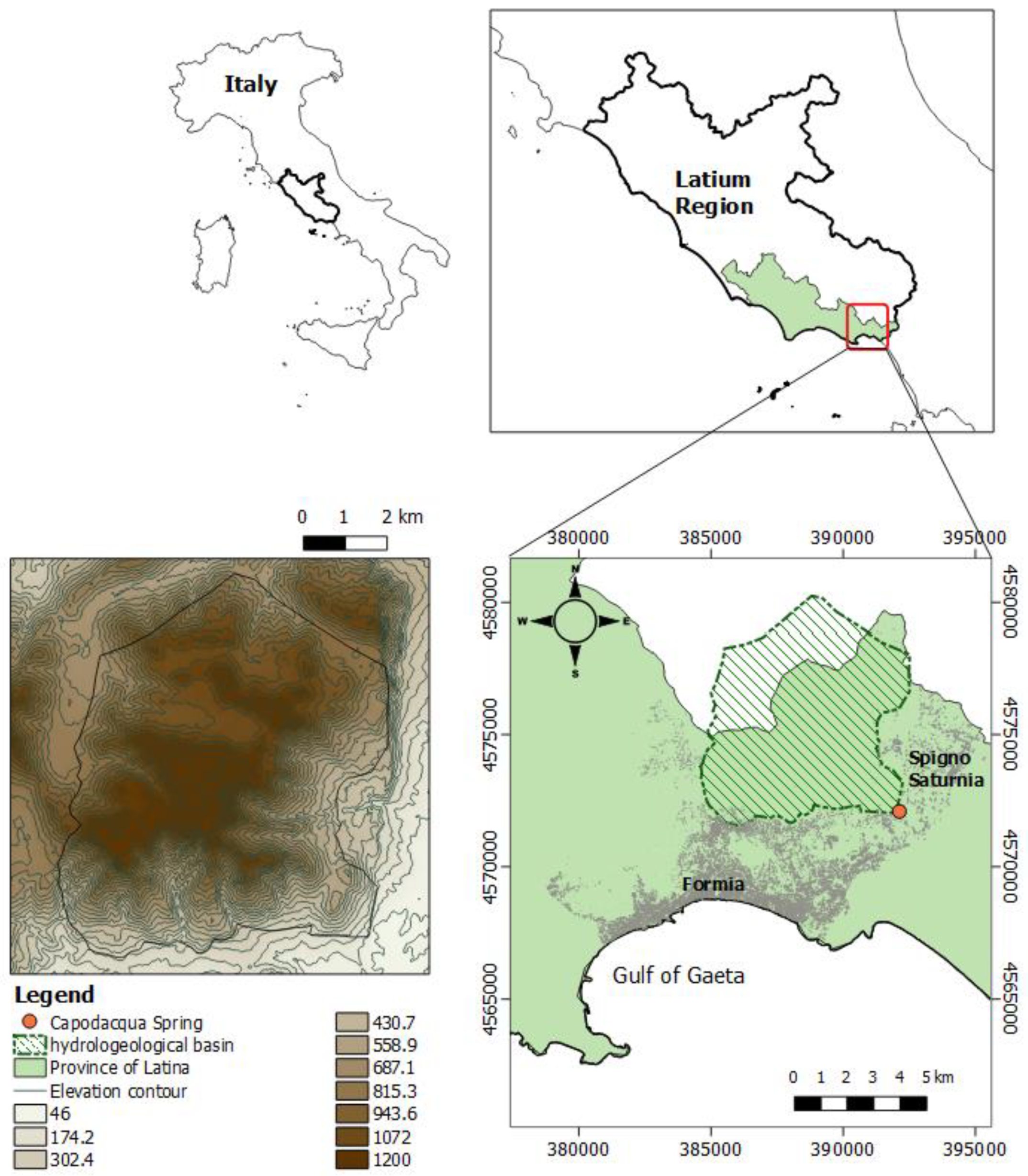
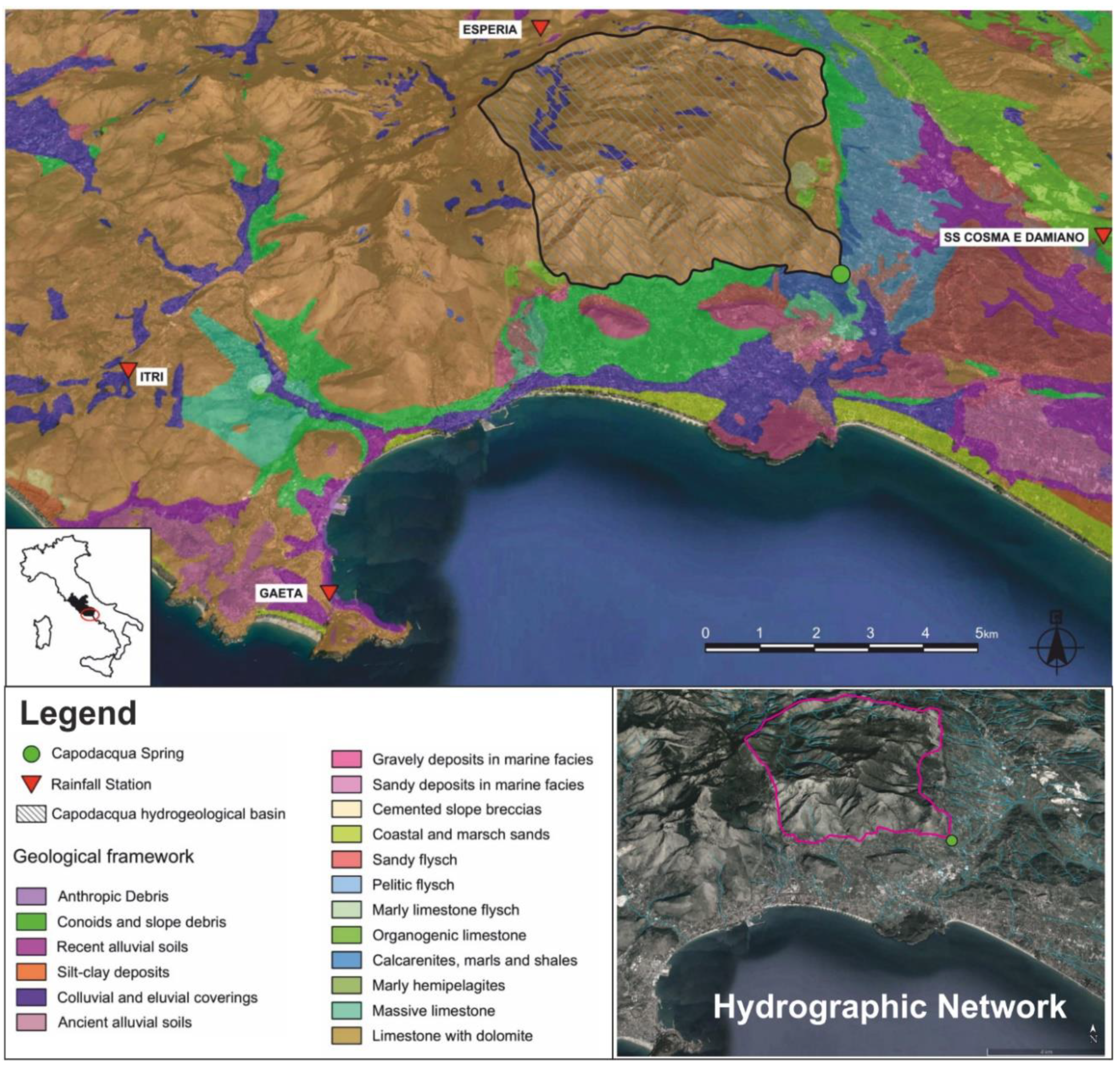
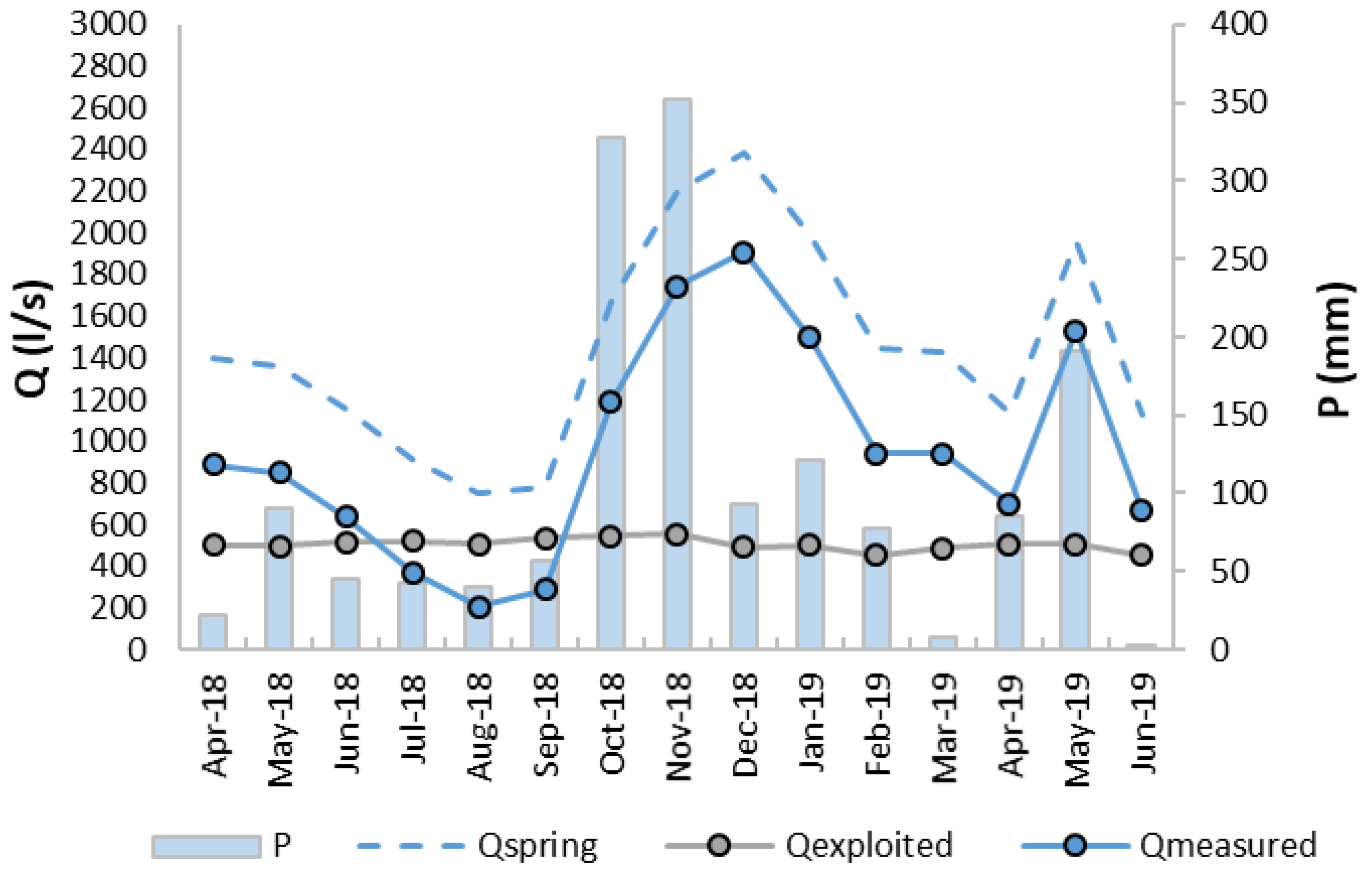
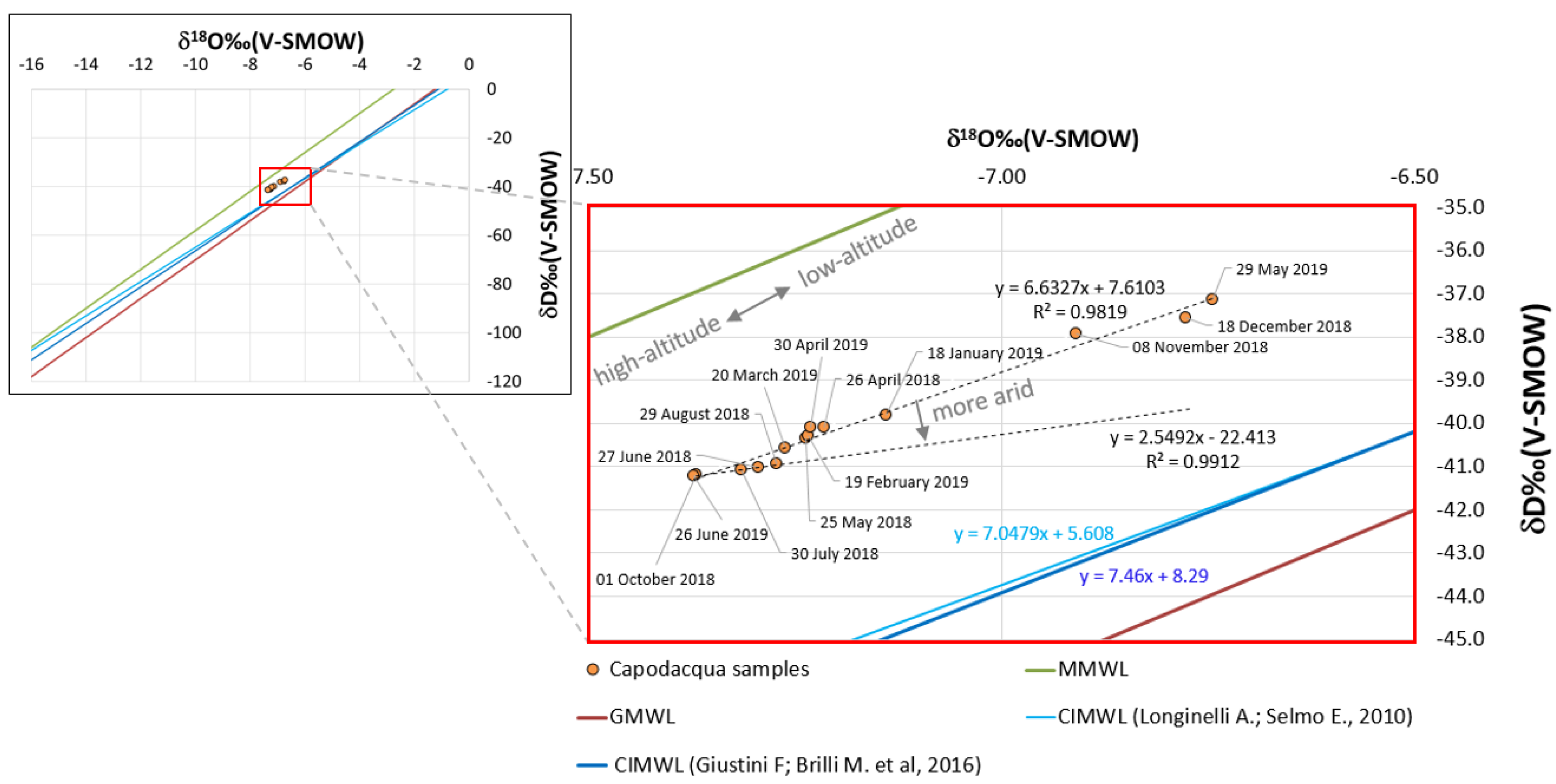
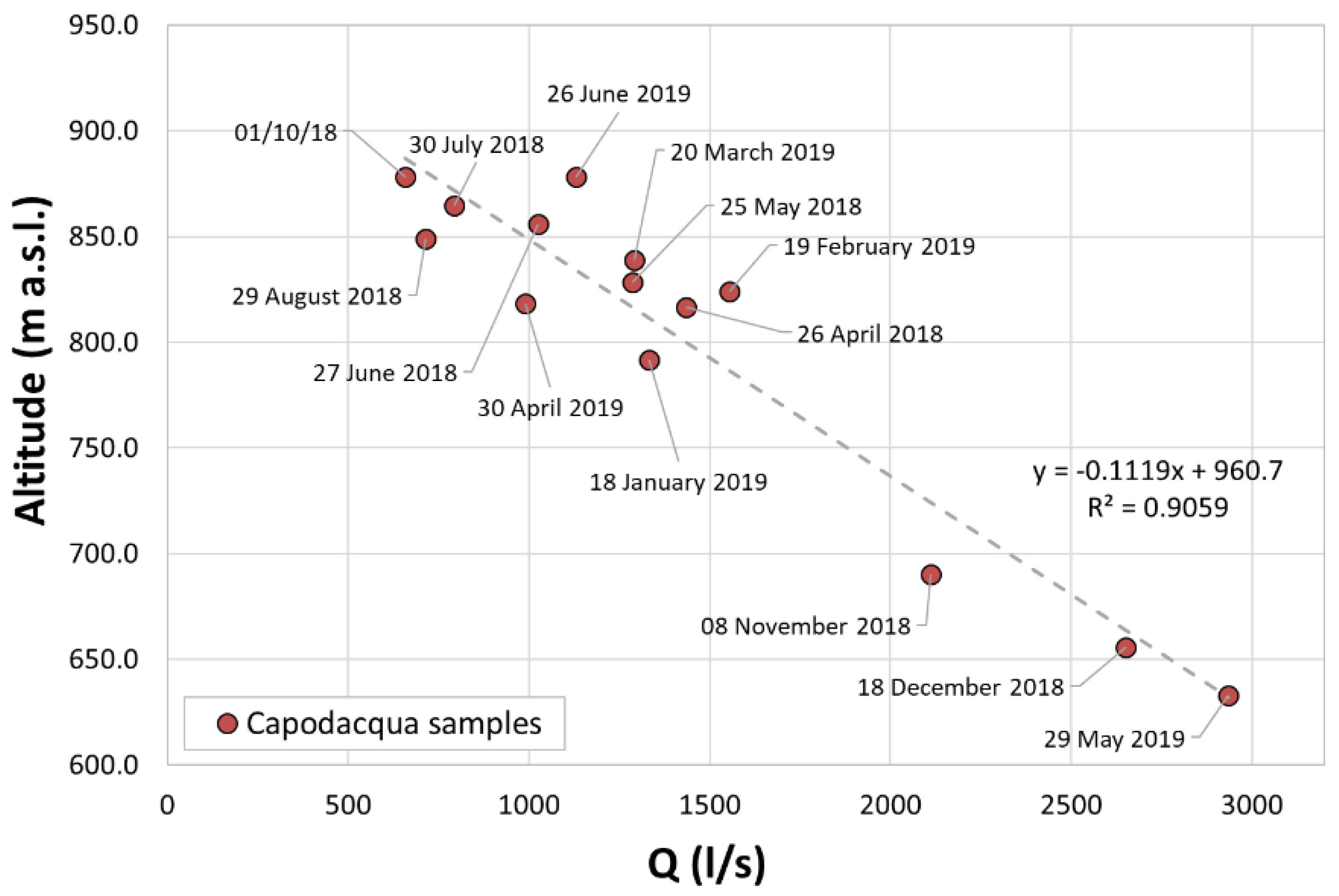
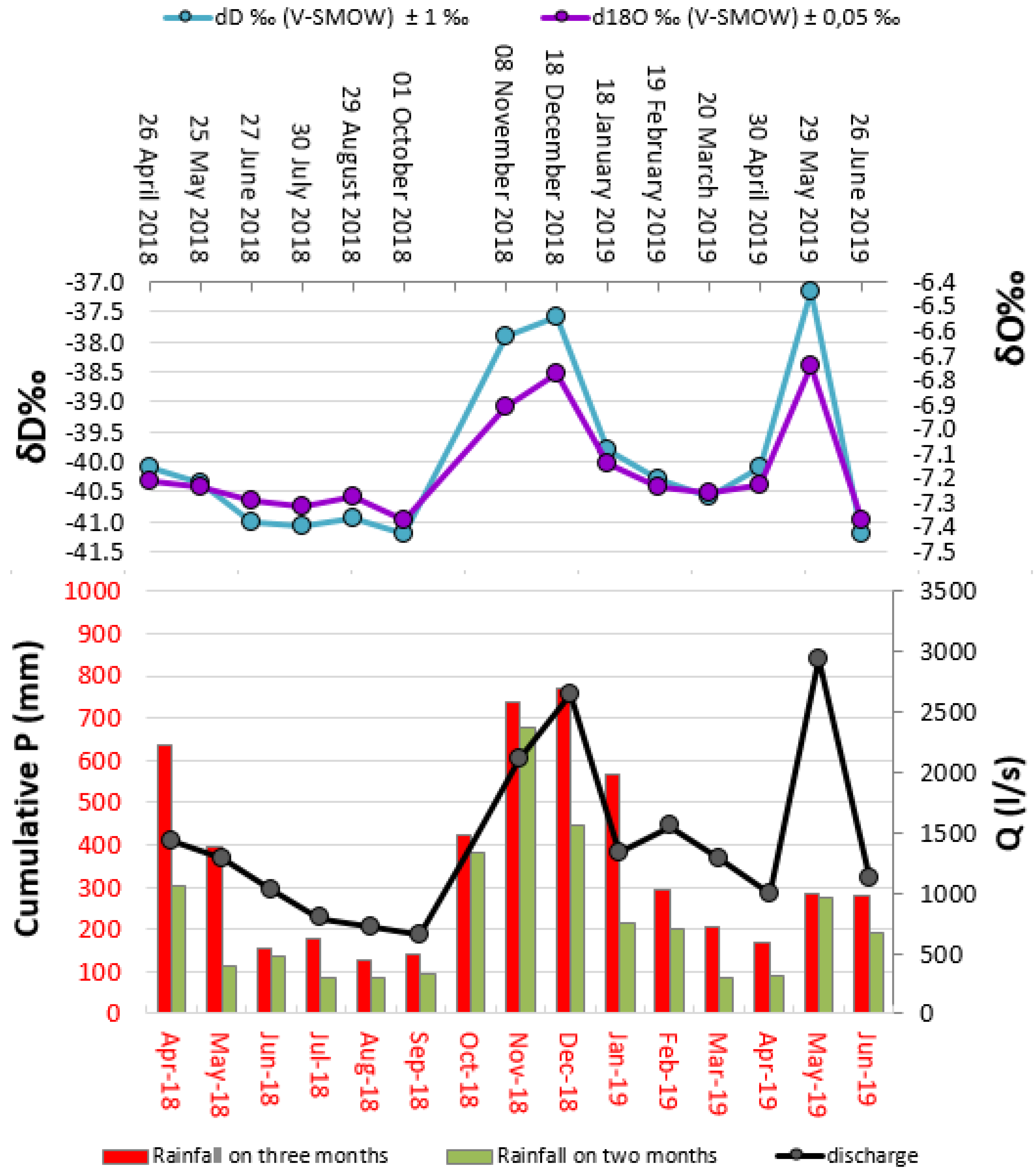
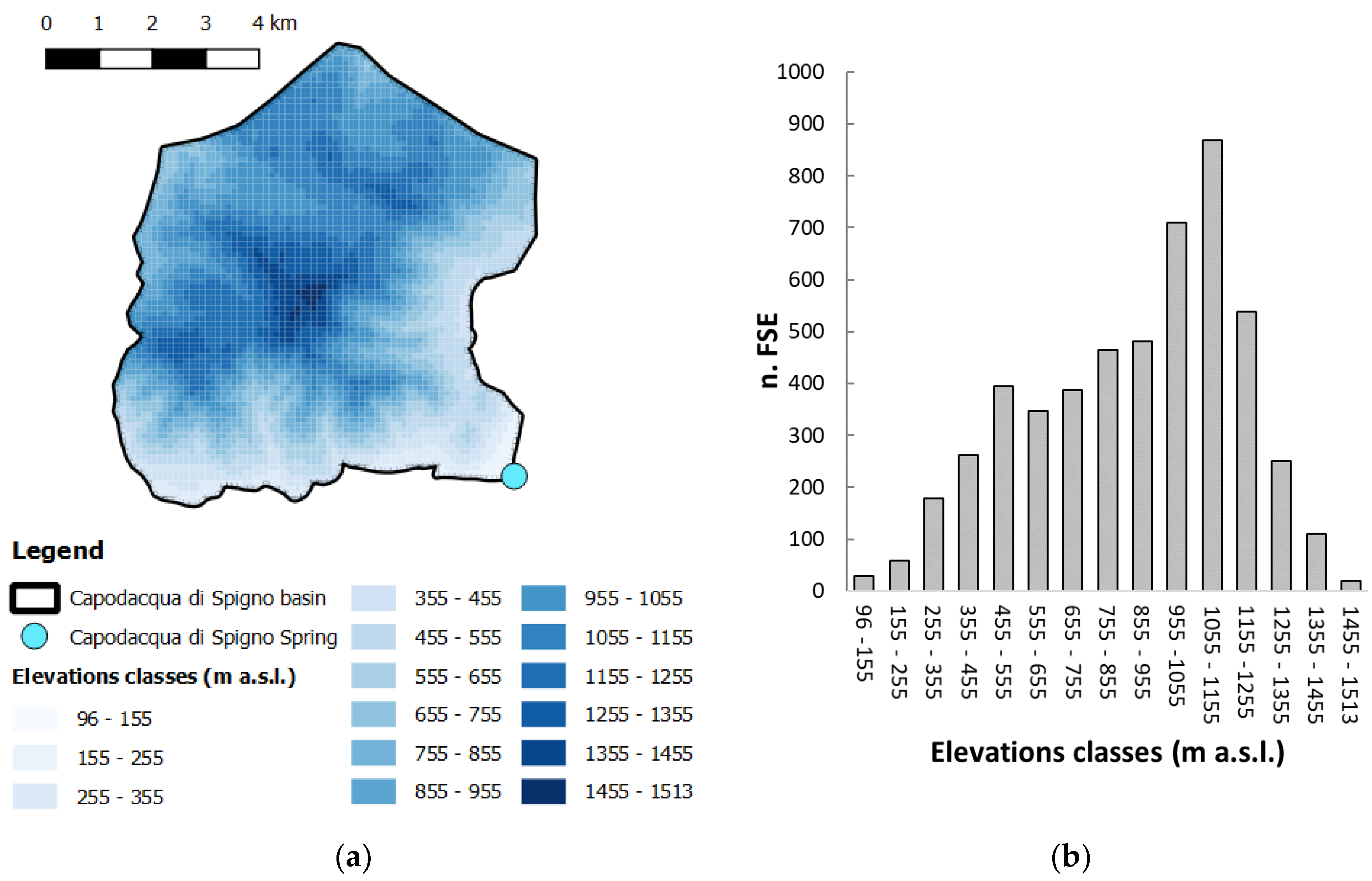
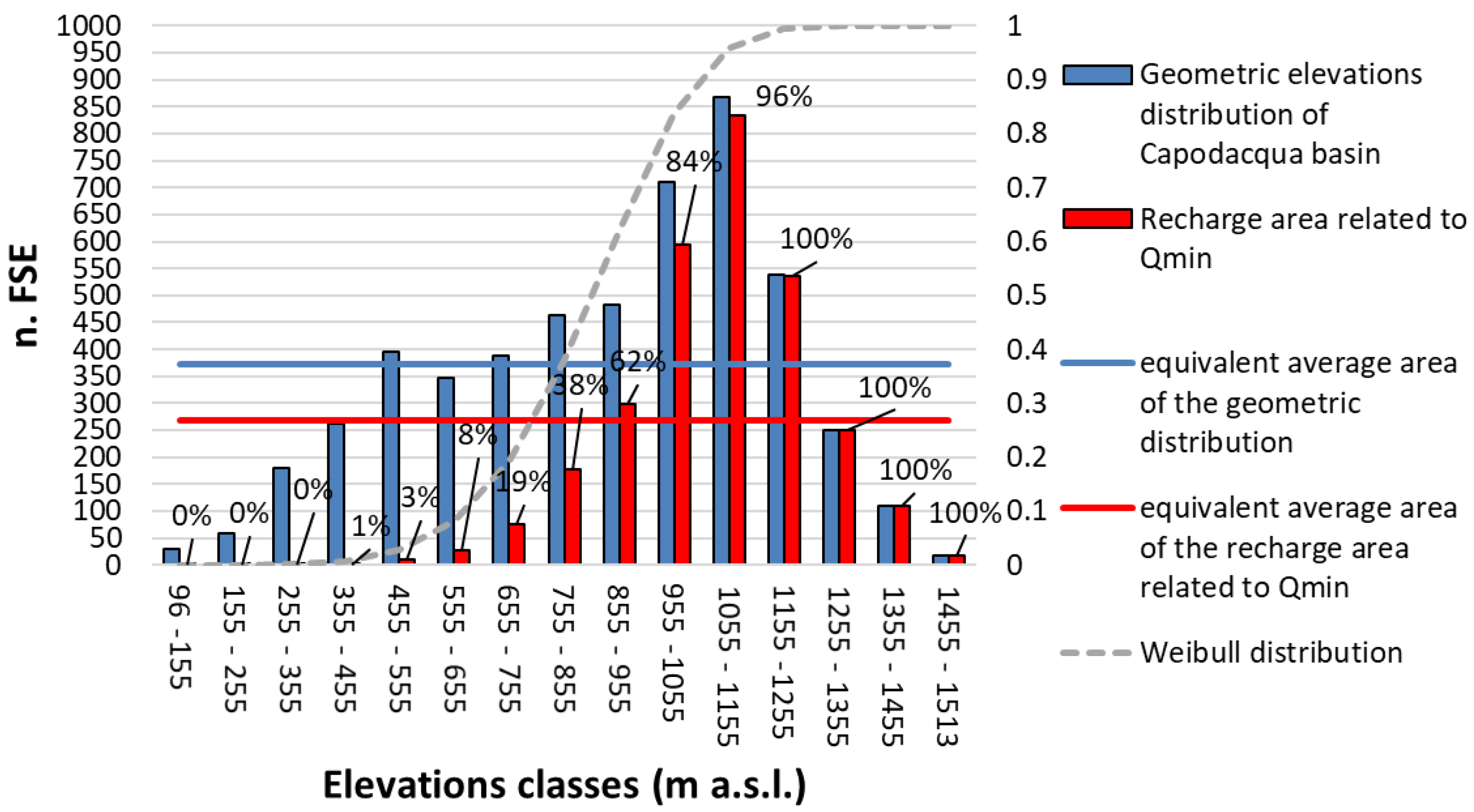
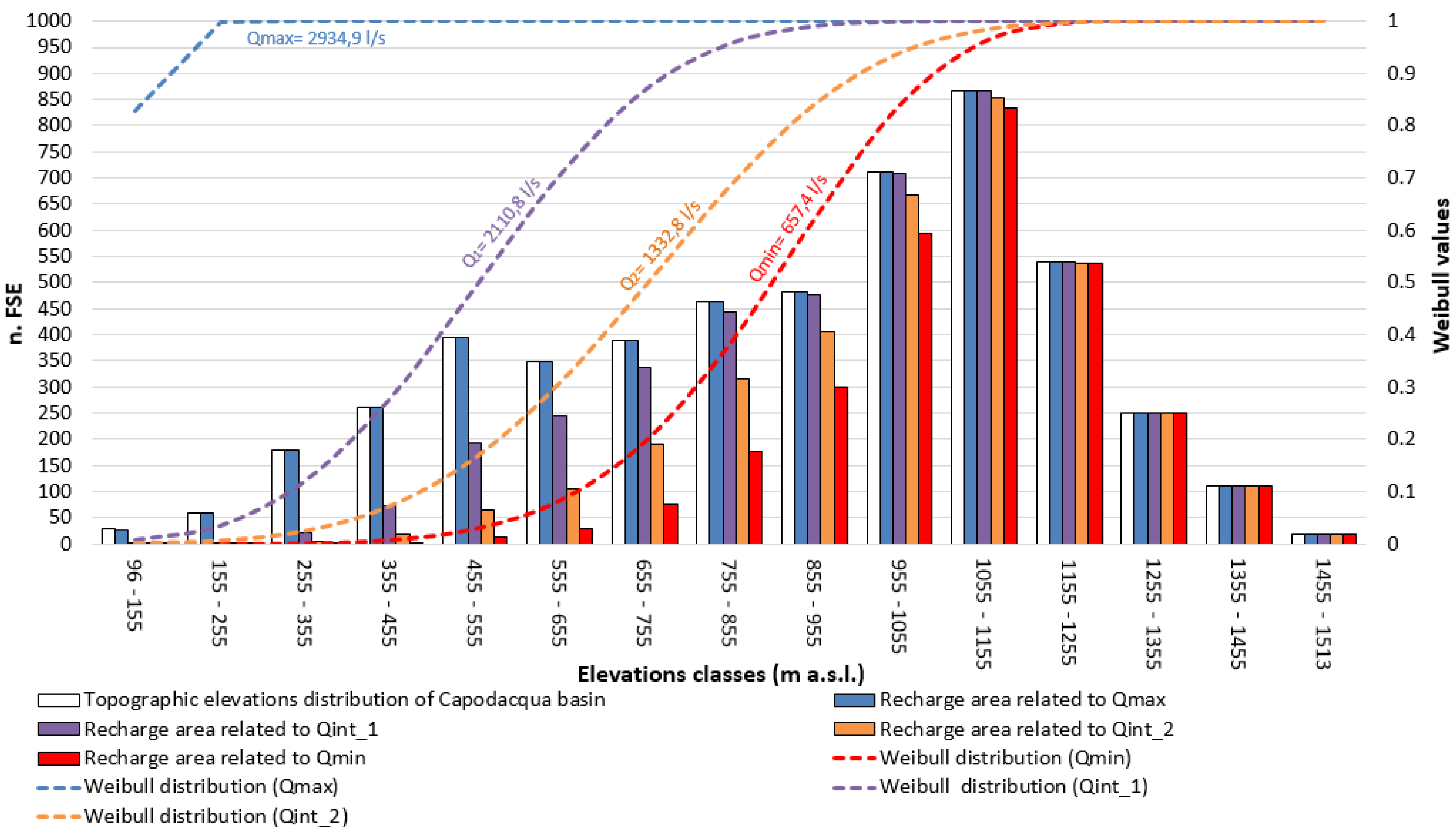
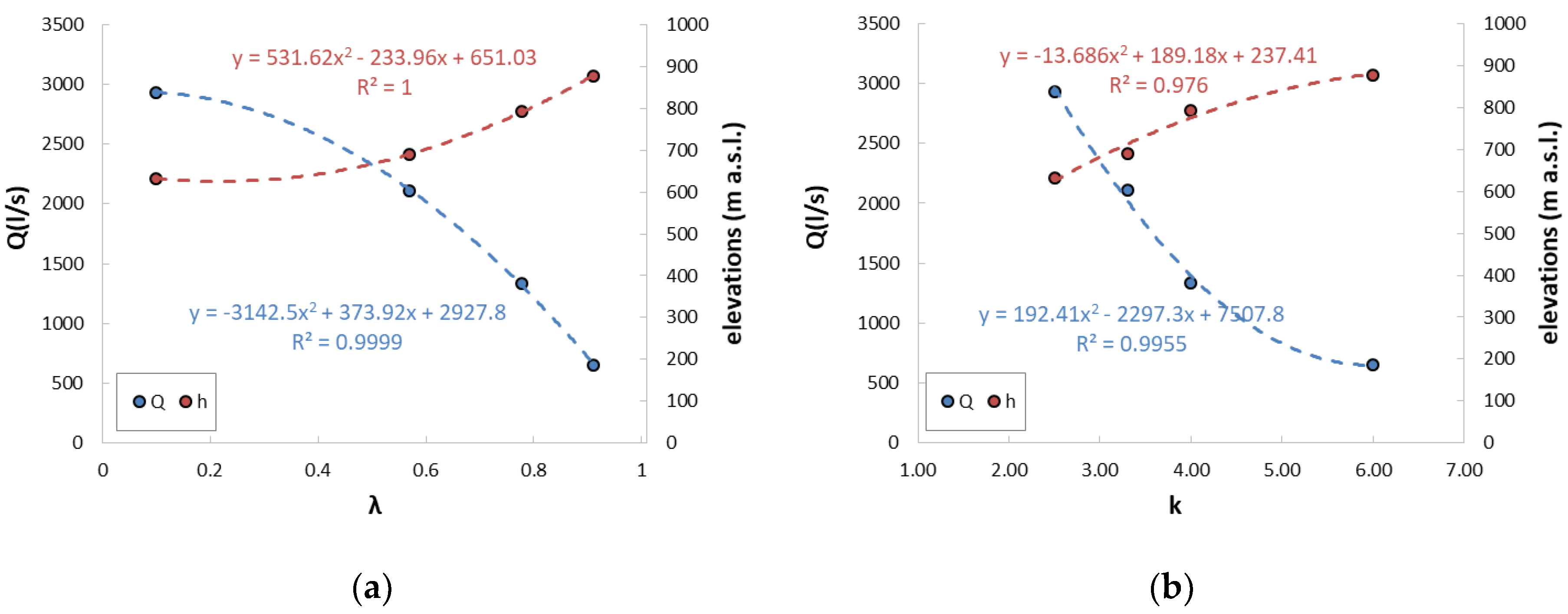
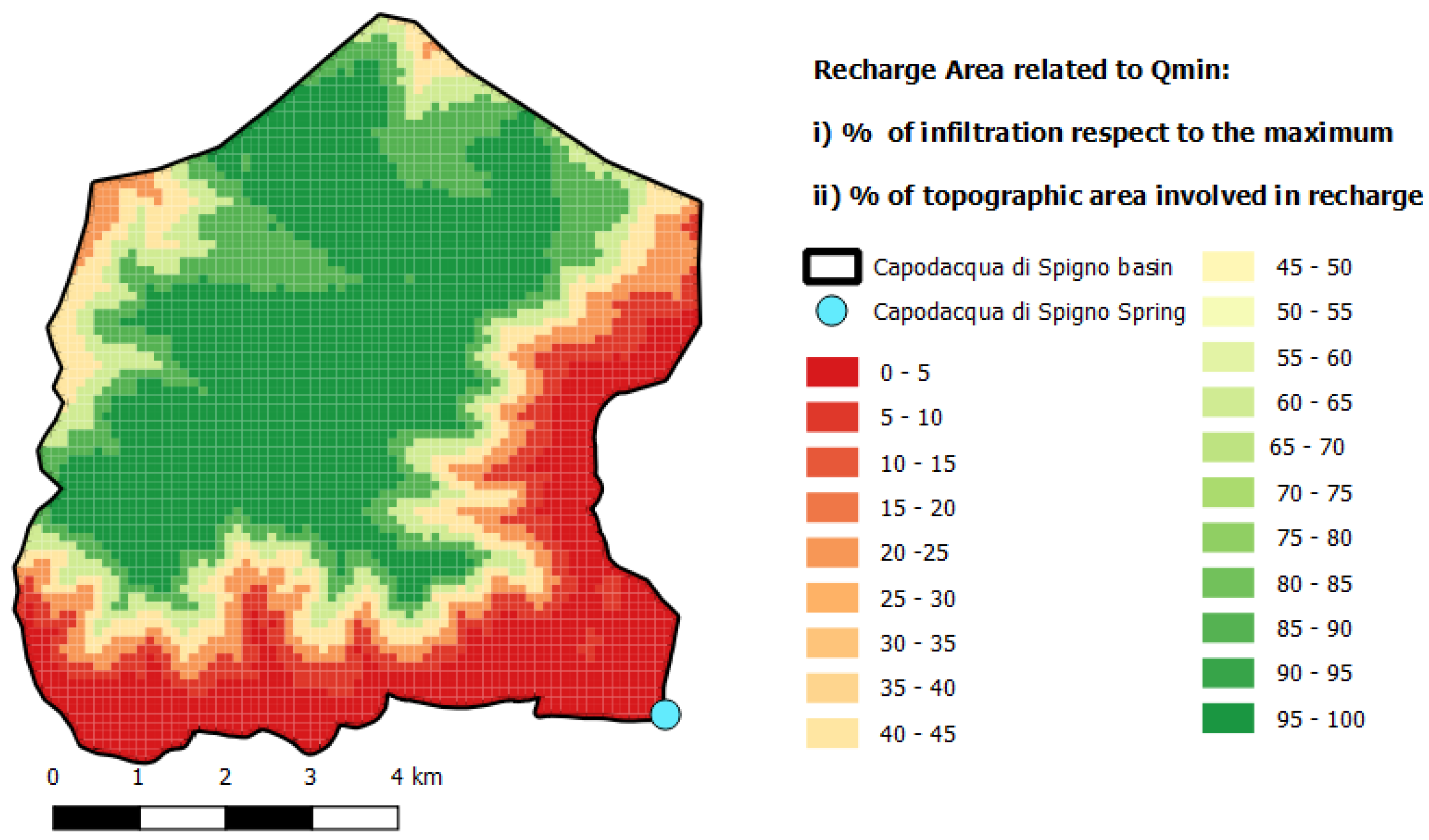
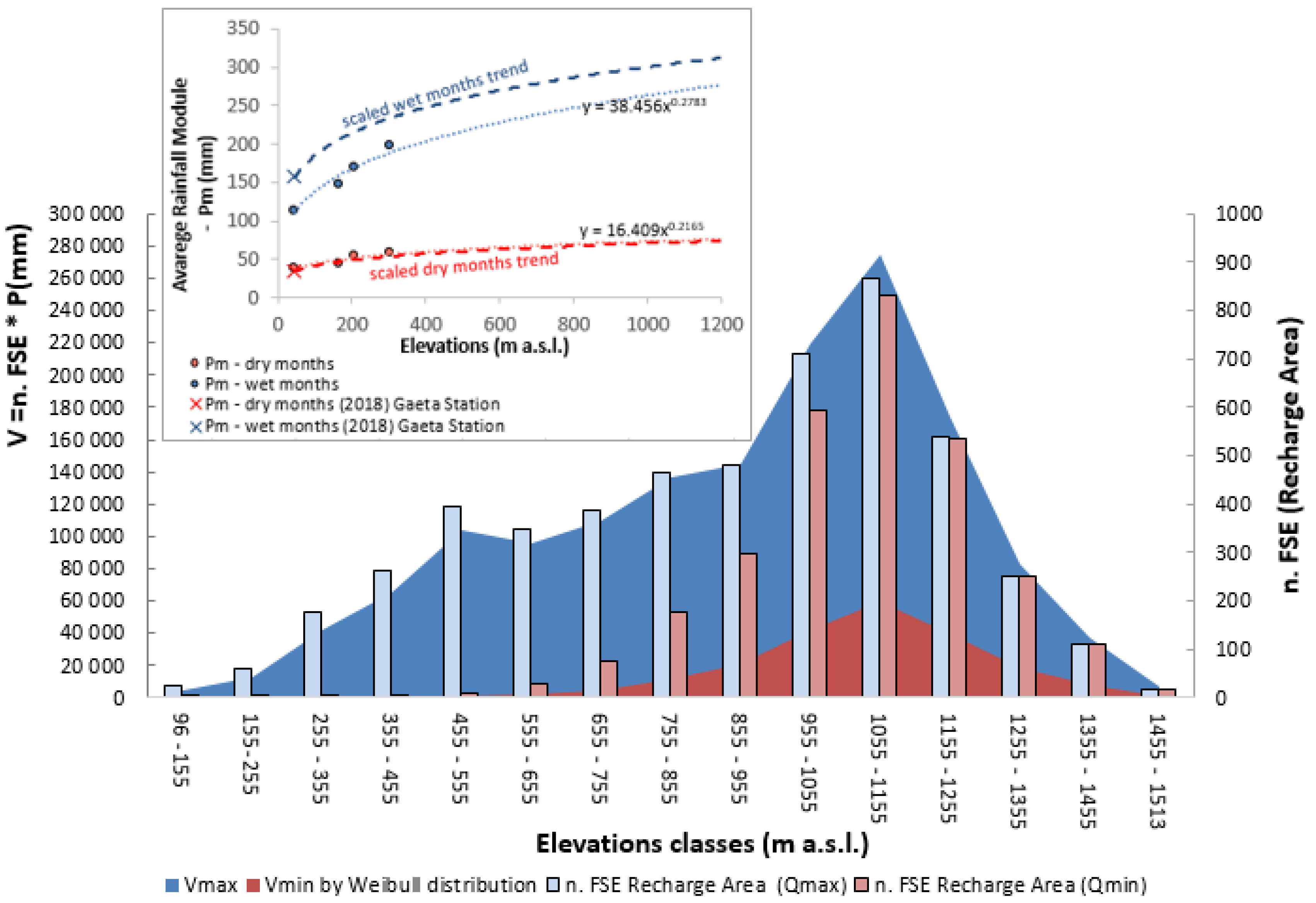
| Date | δ18O (‰ VSMOW) | δ2H (‰ VSMOW) |
|---|---|---|
| 26 April 2018 | −7.2 | −40.1 |
| 25 May 2018 | −7.2 | −40.4 |
| 27 June 2018 | −7.3 | −41.0 |
| 30 July 2018 | −7.3 | −41.1 |
| 29 August 2018 | −7.3 | −40.9 |
| 01 October 2018 | −7.4 | −41.2 |
| 08 November 2018 | −6.9 | −37.9 |
| 18 December 2018 | −6.8 | −37.6 |
| 18 January 2019 | −7.1 | −39.8 |
| 19 February 2019 | −7.2 | −40.3 |
| 20 March 2019 | −7.3 | −40.6 |
| 30 April 2019 | −7.2 | −40.1 |
| 29 May 2019 | −6.7 | −37.2 |
| 26 June 2019 | −7.4 | −41.2 |
| Date | Qe (l/s) | Qm (l/s) | Qs (l/s) |
|---|---|---|---|
| 26 April 2018 | 519.57 | 915.00 | 1434.57 |
| 25 May 2018 | 505.80 | 780.00 | 1285.80 |
| 27 June 2018 | 537.00 | 490.00 | 1027.00 |
| 30 July 2018 | 542.85 | 250.77 | 793.62 |
| 29 August 2018 | 554.20 | 159.00 | 713.20 |
| 01 October 2018 | 489.02 | 168.42 | 657.44 |
| 08 November 2018 | 454.17 | 1656.66 | 2110.83 |
| 18 December 2018 | 486.26 | 2163.50 | 2649.76 |
| 18 January 2019 | 503.40 | 829.41 | 1332.81 |
| 19 February 2019 | 504.40 | 1050.16 | 1554.56 |
| 20 March 2019 | 454.39 | 836.56 | 1290.95 |
| 30 April 2019 | 433.16 | 558.05 | 991.20 |
| 29 May 2019 | 434.93 | 2500.00 | 2934.93 |
| 26 June 2019 | 458.03 | 671.46 | 1129.48 |
| Q (l/s) | h (m a.s.l.) | λ | k | |
|---|---|---|---|---|
| Qmax | 2934.9 | 633.0 | 0.10 | 2.50 |
| Q1 | 2110.8 | 690.0 | 0.57 | 3.30 |
| Q2 | 1332.8 | 791.5 | 0.78 | 4.00 |
| Qmin | 657.4 | 878.0 | 0.91 | 6.00 |
© 2020 by the authors. Licensee MDPI, Basel, Switzerland. This article is an open access article distributed under the terms and conditions of the Creative Commons Attribution (CC BY) license (http://creativecommons.org/licenses/by/4.0/).
Share and Cite
Iacurto, S.; Grelle, G.; De Filippi, F.M.; Sappa, G. Karst Spring Recharge Areas and Discharge Relationship by Oxygen-18 and Deuterium Isotopes Analyses: A Case Study in Southern Latium Region, Italy. Appl. Sci. 2020, 10, 1882. https://doi.org/10.3390/app10051882
Iacurto S, Grelle G, De Filippi FM, Sappa G. Karst Spring Recharge Areas and Discharge Relationship by Oxygen-18 and Deuterium Isotopes Analyses: A Case Study in Southern Latium Region, Italy. Applied Sciences. 2020; 10(5):1882. https://doi.org/10.3390/app10051882
Chicago/Turabian StyleIacurto, Silvia, Gerardo Grelle, Francesco Maria De Filippi, and Giuseppe Sappa. 2020. "Karst Spring Recharge Areas and Discharge Relationship by Oxygen-18 and Deuterium Isotopes Analyses: A Case Study in Southern Latium Region, Italy" Applied Sciences 10, no. 5: 1882. https://doi.org/10.3390/app10051882
APA StyleIacurto, S., Grelle, G., De Filippi, F. M., & Sappa, G. (2020). Karst Spring Recharge Areas and Discharge Relationship by Oxygen-18 and Deuterium Isotopes Analyses: A Case Study in Southern Latium Region, Italy. Applied Sciences, 10(5), 1882. https://doi.org/10.3390/app10051882







